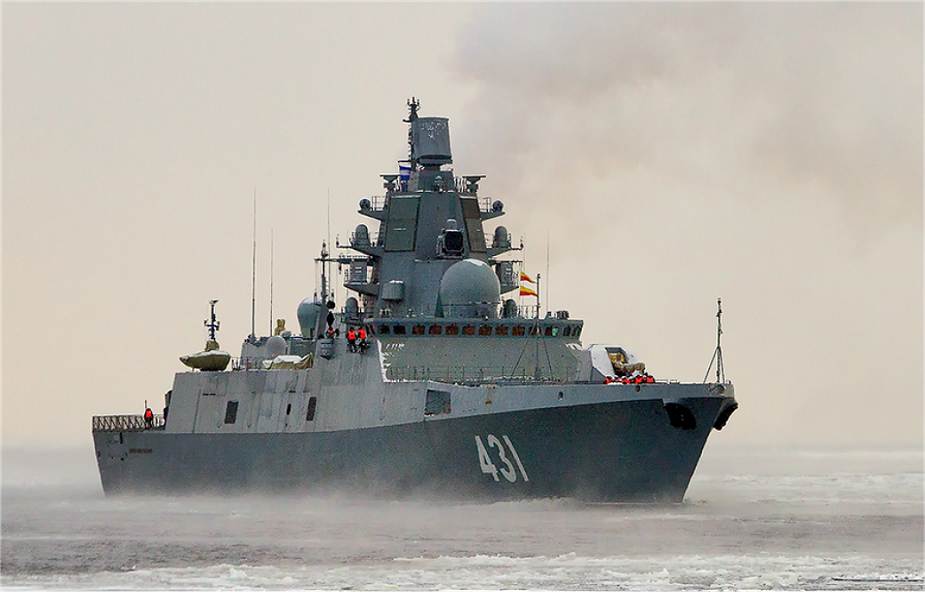Breaking news
Russian Navy Admiral Kasatonov frigate has successfully fired Kalibr anti-ship missile.
According to information published by the Russian press agency TASS on November 13, 2020, the Russian Navy Admiral Kasatonov Admiral Gorshkov class frigate of project 22350 of the Northern fleet successfully fired Kalibr anti-ship missile at a coastal target, the Russian Defense Ministry said.
Follow Navy Recognition on Google News at this link
 Russian Navy Admiral Kasatonov Admiral Gorshkov class frigate of project 2235. (Picture source riafan.ru)
Russian Navy Admiral Kasatonov Admiral Gorshkov class frigate of project 2235. (Picture source riafan.ru)
“It fired from the White Sea. Kalibr missile successfully hit the target at a distance of 1000 km at Chizha range in Arkhangelsk region,” it said. Northern fleet warships guarded the exercise area. The frigate earlier trained artillery fire in the Barents Sea. On September 29, 2020, Admiral Kasatonov fired a Kalibr missile at a ground target in the Arkhangelsk region.
The 3M-54 Kalibr, also referred to it as 3M54-1 Kalibr, 3M14 Biryuza (NATO codenames SS-N-27 Sizzler and SS-N-30A), 91R1, 91RT2 is a group of Russian surface ship-, submarine-launched and airborne anti-ship and coastal anti-ship (AShM), land-attack cruise missiles (LACM) and anti-submarine missiles developed by the Novator Design Bureau (OKB-8).
Frigates of project 22350 have two universal vertical launchers 3S-54 to fire anti-ship 3M-43 missiles (SS-N-27 Sizzler by NATO classification), cruise missiles 3M-14 at stationary ground targets, and antisubmarine 91RT2 missiles of Kalibr complex and antiship 3M-55 Onix missiles (SS-N-26 Strobile). The Admiral Gorshkov lead frigate of the project has fired hypersonic Tsirkon missile.
The Admiral Kasatonov fired 3M-14 missile to over a thousand km. The missiles were engaged in Syria by warships and submarines, but the range did not exceed 1300 km. The range of 3M-14 with a conventional and nuclear warhead has not been disclosed. The Defense Ministry said a hundred strikes with 3M-14 missiles were delivered in Syria.
The Admiral Kasatonov is an Admiral Gorshkov class frigate Project 22350 of the Russian Navy and the second ship of the class. She was laid down on 26 November 2009 and launched on 12 December 2014. She was commissioned on 21 July 2020. Project 22350 was designed by the Severnoye Design Bureau and incorporates use of stealth technology.[12] As of August 2020, ten vessels have been contracted for delivery by 2027.
The Admiral Gorshkov class frigate or Project 22350 has an overall length of 130 m, a beam of 16 m, and a draft of 16 m. They have operational ranges of more than 4,000 miles and a displacement of 4,500 t. The ship is powered by combined gas turbine and gas turbine (COGAG) propulsion systems including two M90FR boost gas turbines of 27,500 shp. (48,800 kW) and two cruise diesel engine of 5,200 shp. (3,900 kW) connected through two shafts. The ship can reach a top speed of 29.5 knots (54.6 km/h; 33.9 mph) with a maximum cruising range of 4,850 nmi (8,980 km; 5,580 mi) at 14 kn (26 km/h; 16 mph). She has ana zendurance of 30 days.
The Admiral Gorshkov Class frigate is fitted with 3D air search radars, Puma fire control radars and sonar suites with hull-mounted LF sonar and LF VDS sonar. She is also equipped with Garpun-BAL SSM targeting and SAM control systems.
The Admiral Gorshkov Class frigate is armed with 16 (2 × 8) UKSK VLS (Vertical Launching Systems) cells for Kalibr, Oniks or Zircon anti-ship cruise missiles and 32 (2 × 16) Redut VLS cells for 9M96, 9M96M, 9M96D/9M96DM(M2) and/or quad-packed 9M100 surface-to-air missiles. The armament of the ship also includes 1 × 130 mm Amethyst/Arsenal A-192M naval gun, two Palash CIWS Close-In Weapon Systems, eight 330 mm torpedo tubes for Paket-NK anti-torpedo/anti-submarine torpedoes and two 14.5 mm MTPU pedestal machine guns.
The Admiral Gorshkov Class features an aft flight deck and hangar to carry advanced Ka-27 NATO code Helix helicopters developed for the Russian Navy to conduct anti-submarine warfare.
© Copyright 2020 TASS Navy Recognition. All rights reserved. This material may not be published, broadcast, rewritten or redistributed.


























